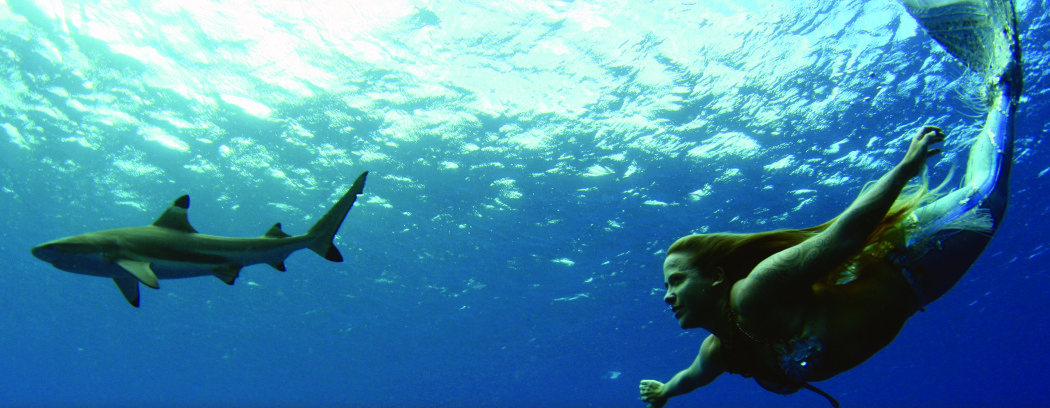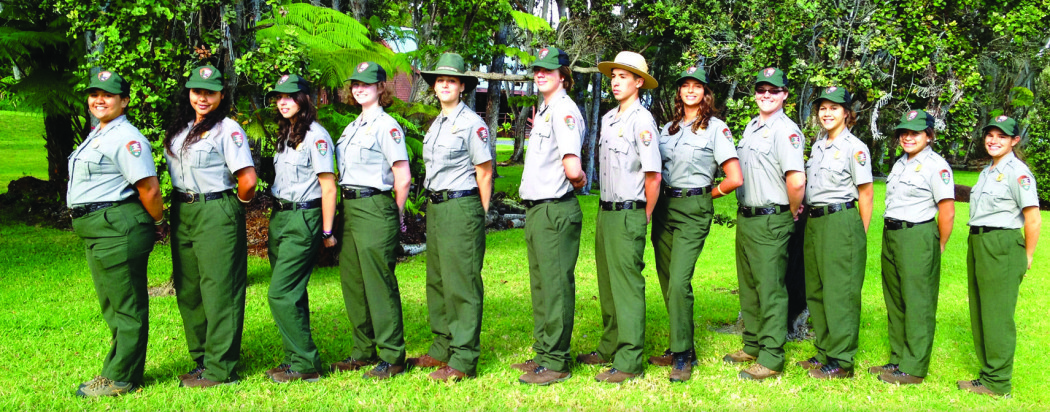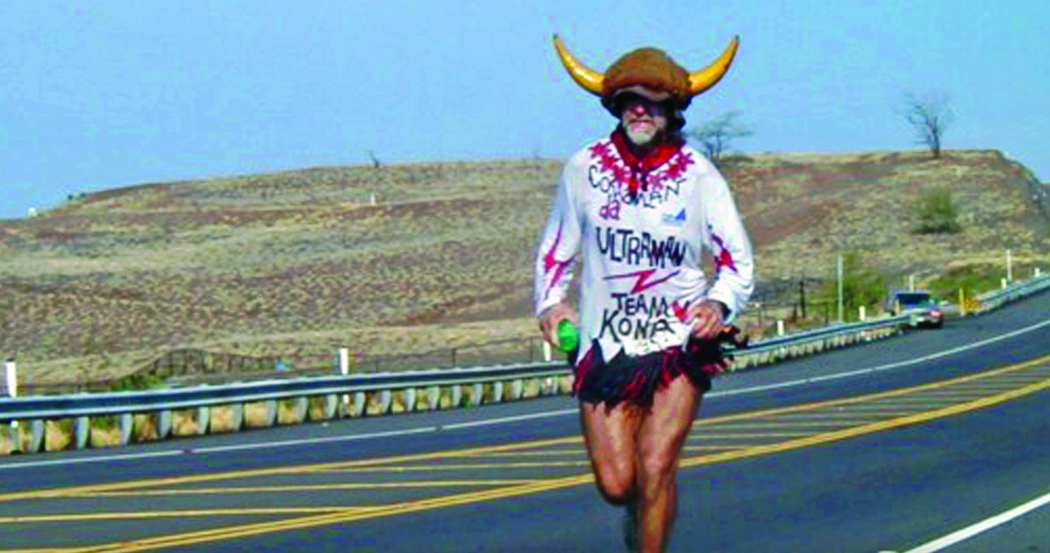
Immersion with a Mermaid: This Kona Marine Mammal Has a True Tale to Tell
 By Marya Mann
By Marya Mann
In a challenge so unifying it has inspired global support among indigenous people, surfers, artists, marine scientists, models, musicians, boat captains, photographers, filmmakers, businesspeople, angel card readers and even Flipper’s original trainer, one Kona resident stands out.
Or swims out. She’s the leading lady of this particular story, Dana Marie Richardson, mermaid.
The protagonist, however, is the one living sea. Ocean activists like 34-year-old Dana have mobilized their life-long passion for the sea into a planet-wide effort to educate everyone that brutal activities and polluting industries endanger not only marine species, but the entire circle of life.
“I want to inspire (everyone) with the magic of the sea,” she says, sitting in her human form at a seaside table overlooking Holualoa Bay as she lunches on fresh salad with broiled mahi mahi. “I want to share awareness of what’s going on and how important the ocean, the dolphins and whales are, how much we need them for our survival.”
She hands me a shell, an opaque spiral on a milky surface tinted with pink. A perfect Fibonacci spiral, inscribed by time and the sea on the face of the tiny hemisphere. “It’s from Polynesia, she says. “The salt water fades away the initial brown color of the shell and leaves a perfect spiral.” Like an unfolding fern frond representing new life, the shell is to remind me our life source is the ocean.”
The tattoos on her left shoulder and arm, cascading waves with the same spiral forms as the shell following the contour, express her love for the ocean. She points to her bicep: “This is the symbol of Kanaloa, god of the sea.” Waves, tides and seabirds ripple along her human skin, from “interior heart” to the sea star on her big toe.
I first met Dana at the “Minds in the Water” Kona film premiere, which was attended mostly by normal, land-based mammals, but with a few finned friends too. With her waist-length, green-tinted mermaid’s hair and wearing only her Wahine Toa dress—in other words, not one of the four homemade mermaid tails she often wears—she stood on stage and thanked the sponsors. For someone who prefers fins to feet, it was no small feat to go door-to-door engaging businesses like Moku Nui, Quaysha Swimwear, Clark Little and 30 more contributors, inviting them to get serious about the tipping point we face.
She organized the event to feature the Independent Spirit Award-winning documentary following professional surfer Dave Rastovich and his friends as they sailed on Hobie kayaks for 36 days to protect dolphins, whales and the oceans. More than 125 people from all over the Big Island showed up at the Aloha Theater to support our one ocean and the groups working to save it: Women for Whales, Surfers for Cetaceans and the South Atlantic Whale Sanctuary.
Now, here at Lava Java, she says, “It’s hard for people to think how bad it might be elsewhere in the world. In Kona we have the cleanest harbor I’ve seen in my entire life. But you go to the Red Sea, it’s polluted. California coasts, they all have evidence that pollution is happening. Here, we see the ocean full of life, but it’s all one sea. People don’t think about the big plastic gyre; it’s out of sight and out of mind. But it’s affecting the ocean and all sea life on a large scale which is ultimately affecting us as well.”
Creating Understanding
“With ‘Women for Whales,’ we wanted to take a loving approach so people are more interested in learning more,” says Dana, who is also a boat captain, an underwater photographer and a marine mammal naturalist. “If you go to school and you’re force-fed something, you don’t want to learn. But if you learn about the magic and wonder of the sea, the magic key will open the door. We are trying to inspire through the magic of the sea, to share how important the mammals are, how we need them for our survival.
As the wave action of late-morning tide serenaded us, urging itself with rhythmic perfection upon the Kona coast, Dana explained the circle of life in the ocean. “We need the dolphins, whales and sharks, the coral reef, plankton. Everything is connected. It’s a complete circle of life. Without coral, there would be no waves. With no waves, the fish would die out. Without fish, there would be no dolphins. Gradually, things will go extinct without that complete circle of life.
“Our planet is 70-percent water, we’re 70-percent water. So we will go away without the sea.” We’re silent for a moment, hearing only the blue heart of the earth in its steady backbeat of wave action. What if the heart of the planet stopped beating, because we didn’t act to protect it?
Mermaid Talk Story
As a mermaid, Dana becomes a provocative, compelling voice for the sea, calling us to action and inspiring future ocean ambassadors. She conducts a multitude of educational projects for all ages, using the mermaid persona to entice, entrance and encourage her students to become one with the sea.
The romantic legends of mermaids as water nymphs waiting to snare unwary sailors with their haunting songs have delighted all generations in all parts of the world. Their music drives men wild, cautioned the enchantress Circe to Odysseus in ancient Greece. The oldest mermaid in mythology, the goddess Atargatis from Syria, embodied the same contradictory qualities we see in the sea: beautiful, cruel, tender, loving and destroying. Since the time of the great voyages from Tahiti to Hawai‘i, writes Kohana Au in Tales of the Mermaids of Waiahuakua, mermaids have also been a part of Pacific legend and lore. The goddess Moananuikalehua, who lived in the channel between Kaua‘i and O‘ahu, was said to be Pele’s best friend.
The mermaid, a fantastical creature, is like nature herself; she gives comfort and expresses truth. “The ocean is alive with so much life,” Dana Mermaid muses. “From the coral reefs to the phytoplankton to the shark and ray species to the fish and turtles and then, of course, the marine mammals—the whales and dolphins.”
What’s so special about whales and dolphins, she says, is their ability to use sonar. “To humans who protest our efforts to help dolphins, I want to say, ‘Do you know how to use sonar? It’s like x-ray vision. Not only that, they’re so in tune, dolphins and whales have the ability to communicate through energy. They don’t have all that extra stuff that we do on land; it covers up our intuition, our energy. That stuff isn’t there underwater.’”
There’s a unity in the sea, she says. “If there’s a ripple, it affects everything. We rise and fall on the same sea. We are all in the same water, a community, like in old Hawai‘i, one ‘ohana.”
Marine mammals, she says, “are much more highly developed than humans. Their brain is larger and they probably use more of it.”
This is one reason she prefers to meditate in the same way dolphins do. “They go into an alpha state and just shut their brains down. I’m working up to shutting half my brain down and slowing my heart rate, entering that peaceful state, watching the thoughts and emotions, and opening the heart space. That’s how dolphins rest,” she says. “They found out years ago with a captive dolphin who was put under anesthesia for surgery. He died because dolphins are conscious breathers and they have to stay awake in order to breathe.”
But they need to rest, so they have evolved the ability to have one eye open and one eye closed. They swim much like a flock of birds, flowing together as a group, which is a safer state. “They breath rhythmically, enter into a meditative state, slow down the heart, then they’ll wake up a bit and play then shut down the other side of the brain. So they get meditative catnaps all day.”
One pod might be in their rest cycle while another pod will be floating nearby, a little more awake, maybe a little protectively. “A guardian pod,” explains Dana. “No one really knows for sure. There’s so much we still need to learn. So much of it is our interpretation of their behavior, but they seem to be a group consciousness rather than having an alpha/leader of the pod.
“What I try to do is share a deep respect for the sea and all sea life, carrying that message in a way for people who may be ignorant of it. Many people have separated from the connection we have to the sea, but whether you live near the sea or completely surrounded by land, you are still connected to the ocean. It is our ultimate life source.”
The Mermaid Emerges
Dana felt like a fish out of water in her hometown of Phoenix, Arizona, where her “gills went dry” she says. “I swam in the pool until my hair turned greenish and my skin was wrinkled and sun- kissed, and still I would resist getting out of the water!”
She recalled using dive rings around her lower body to shift into a mermaid’s tail and the mermaid’s signature solo fin. “I would hold tea parties underwater, practice breath holds and dream of communicating with whales and dolphins in the sea. I imagined them calling to me.” Later she crafted fabric tails and learned to swim with them.
Dana’s parents encouraged her youthful “mermaiding,” teaching her to “believe that anything is possible.” Believing in the existence of mermaids, it made perfect sense to become one. “When I visited the ocean, words can’t express the feeling but it was much like coming home.” Before long, she was able to free dive to over 100 feet and developed a static breath hold of five minutes.
Becoming a U. S. Coast Guard licensed boat captain for up to 50 tons, she began doing fieldwork and research with all species of marine mammals, especially the 32 species of whales and dolphins that reside in Kona year-round as well as the migrating humpbacks that appear in winter. Based on her close relationship to dolphins, she’s been hired for documentary projects to be a dolphin decoy and bring the dolphins closer to the camera.
In my work as a mermaid, I’m not a model,” she insists. “Taking photos of my mermaiding is fun, but there are so many deeper levels to it. The ocean is a healing source of life with so much to teach us. When people swim in a tail, they connect to the sea in a deeper way, fully experiencing its bliss and wonder.”
Through her mermaiding, ocean adventures and her Sea Sister clothing line, as well as events she sponsors, sharing her love of the ocean is designed to be fun, heart-opening and educational. Her activities also contribute to the larger ocean activist movement that is changing the direction of human enterprise.
Ever since the film “The Cove” won the 2009 Academy Award for best documentary after exposing the cruel killing of defenseless dolphins in Japan, a few thousand less dolphins have been killed. Clean-up crews on beaches and seacoasts worldwide are meticulously collecting ocean debris. Ocean naturalists have been attending International Whaling Commission meetings for five years, lobbying for the Atlantic Whale Sanctuary. The effort has not received enough votes to be established, but their plans have expanded, “and each year we are getting closer to whale freedom worldwide,” says Dana.
Hoping to save more whale species, they are now calling for a halt to some of the more deadly commercial shipping, tourist whale-watching traffic and military tests that strike whales or create noise pollution interfering with cetaceans’ sophisticated sonar capabilities.
Myths are more than make-believe. They are stories that endure and continue to arouse us because our deepest human instincts resonate with them. Overfishing has eliminated 90 percent of the big fish in the sea, including sharks and rays. Half the coral reef has disappeared.
Pollution, fossil fuel consumption and the vicious massacres of dolphins and whales are a careless waste of our resources. Today’s mermaids and mermen are breaking out of the old stereotypes and doing the work of saving our seas.
“There really is a whole other world under the sea that comes to life once you dive in under the surface. Magic happens in the ocean. You can hear the fish eating the coral, the shrimp,” she says. “If you’re lucky and happen to be underwater during whale season, you can hear the beautiful chorus of whale song echoing throughout the water, or you can hear cheerful dolphin sounds or be graced with their sonar.”
Dana Mermaid’s siren calls are sending out ripples in the sea. Kona Coconut Girls Gina and Michelle were so inspired by the “Minds in the Water” event that they are organizing a new event called “Hearts in the Water” to bring sea-supporters together to stop the Navy’s use of sonar. “Stay tuned for de-tails!” Dana teases.
The story of the one living ocean is not over yet, and the plot is not set in stone, it’s fluid. There is still hope to save the sea creatures; some blue whales and ten percent of the big fish still remain; and half the coral reef is still intact, like a jeweled belt around the equator.
There’s still time, but not a lot, to restore the health of the ocean and protect our heavenly sea before it becomes a paradise lost.
I touch the shell Dana gave me—which the sea gave to her—and I remember that our life source is the ocean, but we humans are the source of saving our one living sea. The time to act is now if we want this story to have a happy ending. ❖
Stay in touch with Dana Mermaid on Facebook and also at DanaMermaid.com or ManaKaiPhoto.com
Contact writer at Marya@LoomOfLove.com


